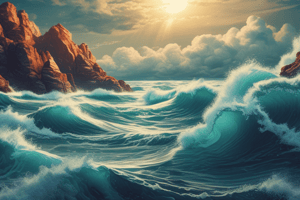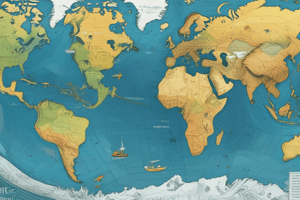Podcast
Questions and Answers
What is the frequency at which diurnal tides normally occur?
What is the frequency at which diurnal tides normally occur?
- The number of occurrences in a tidal day varies by geographic area
- A single high and a single low water occur each tidal day (correct)
- One high or one low water, but not both, occurs in each tidal day
- Two high and two low waters occur each tidal day
Under which conditions do spring tides occur?
Under which conditions do spring tides occur?
- At the start of spring, when the sun is nearly over the equator
- When the sun, moon, and earth are nearly in line, in any order
- Only when the sun and moon are on the same sides of the earth and nearly in line (correct)
- When the sun and moon are at approximately 90 degrees to each other as seen from the earth
Which of the following best describes ebb current?
Which of the following best describes ebb current?
- Vertical movement of water toward the land
- Vertical movement of the water away from the land
- Horizontal movement of the water away from the land (correct)
- Horizontal movement of the water toward the land
How is the speed of tidal current commonly measured?
How is the speed of tidal current commonly measured?
What are tidal current subordinate stations?
What are tidal current subordinate stations?
What is the reference point from which the height of a light is measured?
What is the reference point from which the height of a light is measured?
When do spring tides occur?
When do spring tides occur?
What is the period during high or low tide with no change in water height called?
What is the period during high or low tide with no change in water height called?
Which statement defines spring tides?
Which statement defines spring tides?
What is the primary datum for soundings on charts used in the United States?
What is the primary datum for soundings on charts used in the United States?
What does the term 'range of tide' refer to?
What does the term 'range of tide' refer to?
Which reference datum is used to determine the heights of land features on most charts?
Which reference datum is used to determine the heights of land features on most charts?
How is the height of tide correctly defined?
How is the height of tide correctly defined?
Flashcards are hidden until you start studying
Study Notes
Tide and Current Questions
- The height of a light is measured from mean lower low water.
- Spring tides occur when then moon is new or full
- Neap tides occur when the moon is at quadrature
- The period at high or low tide during which there is no change in the height of the water is called the stand of the tide.
- The term "spring tides" refers to tides with lows lower than normal and highs higher than normal.
- The datum of soundings for charts used in the United States is mean lower low water.
- Tide refers to the vertical movement of water.
- The range of tide is the difference between the heights of successive high and low tides.
- The reference datum used in determining the heights of land features on most charts is mean sea level.
- The height of tide is the vertical distance from the tidal datum to the level of the water at any time.
- On the west coast of North America, charted depths are taken from mean lower low water.
- Mean high water is the average height of high waters.
- Diurnal tides normally occur with a single high and a single low water each tidal day.
- Spring tides occur when the sun, moon and earth are nearly in line, in any order.
- Ebb current is the horizontal movement of the water away from the land.
- The speed of the current is given in knots.
- Tidal current subordinate stations broadcast tidal current information on the radio.
Studying That Suits You
Use AI to generate personalized quizzes and flashcards to suit your learning preferences.




